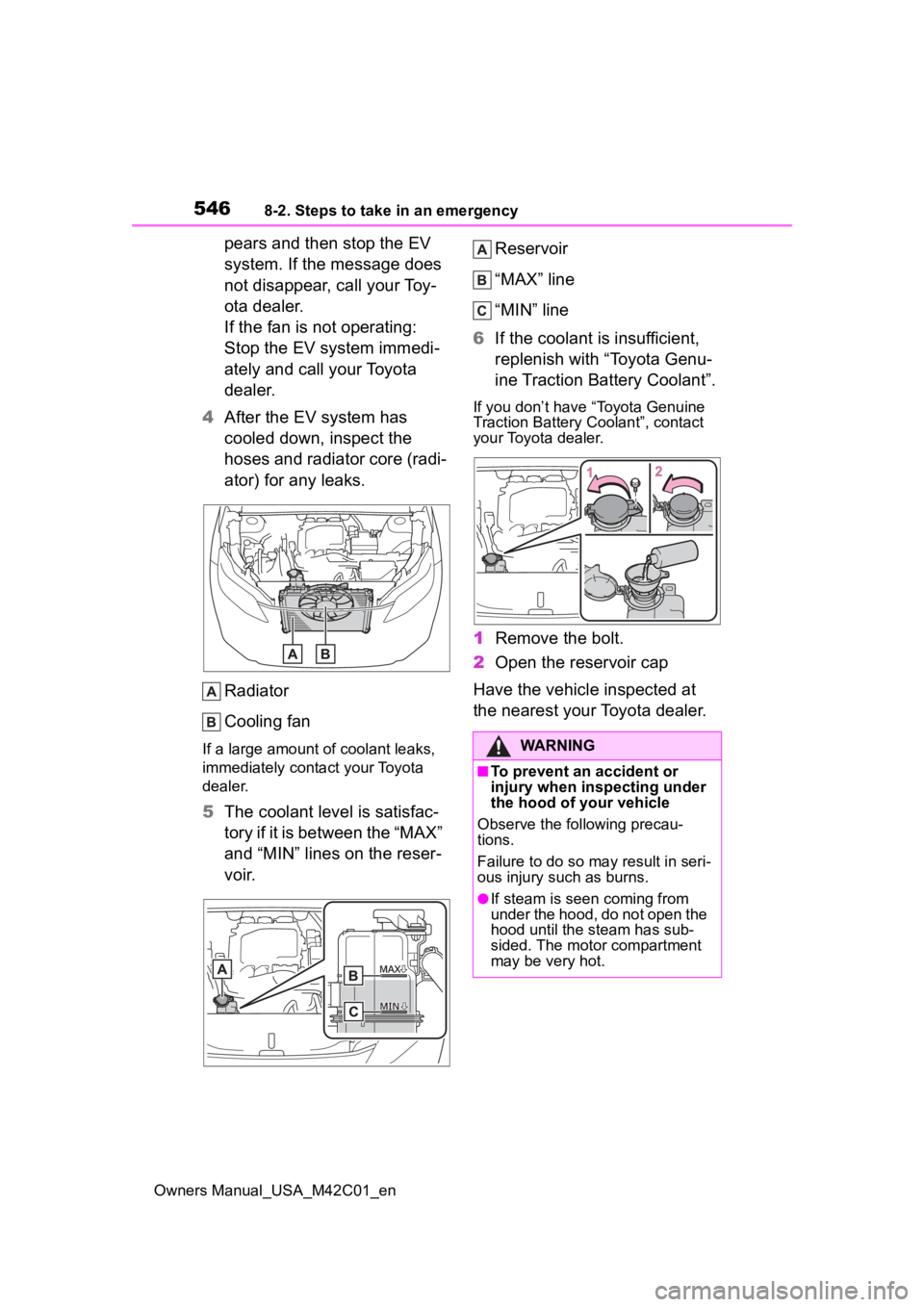Page 545 of 628

5458-2. Steps to take in an emergency
Owners Manual_USA_M42C01_en
8
When trouble arises1 Stop the vehicle in a safe
place and turn off the air con-
ditioning system.
2 Leave the EV system operat-
ing and carefully lift the hood.
3 Check if the cooling fan is
operating.
If the fan is operating:
Wait until the “EV System
overheated Output power
reduced” message disap-
WARNING
■When replacing the 12-volt
battery
●When the vent plug is close to
the hold down cl amp, the bat-
tery fluid (acid) may leak.
●For information regarding bat-
tery replacement, contact your
Toyota dealer.
NOTICE
■When handling jumper cables
When connecting the jumper
cables, ensure that they do not
become entangled in the cooling
fan.
If your vehicle over-
heats
When “EV System over-
heated Output power
reduced” is shown on the
multi-information display,
your vehicle may be over-
heating.
NOTICE
■Cooling system coolant
The radiator coolant is exclusive
for radiator usage. Damage may
occur when water or any other
type of coolant is used, so never
use any other fluid. When there is
no “Toyota Genuine Traction Bat-
tery Coolant”, immediately contact
your Toyota dealer.
Correction procedures
Page 546 of 628

5468-2. Steps to take in an emergency
Owners Manual_USA_M42C01_en
pears and then stop the EV
system. If the message does
not disappear, call your Toy-
ota dealer.
If the fan is not operating:
Stop the EV system immedi-
ately and call your Toyota
dealer.
4 After the EV system has
cooled down, inspect the
hoses and radiator core (radi-
ator) for any leaks.
Radiator
Cooling fan
If a large amount of coolant leaks,
immediately cont act your Toyota
dealer.
5 The coolant level is satisfac-
tory if it is between the “MAX”
and “MIN” lines on the reser-
voir. Reservoir
“MAX” line
“MIN” line
6 If the coolant is insufficient,
replenish with “Toyota Genu-
ine Traction Battery Coolant”.
If you don’t have “Toyota Genuine
Traction Battery Coolant”, contact
your Toyota dealer.
1Remove the bolt.
2 Open the reservoir cap
Have the vehicle inspected at
the nearest your Toyota dealer.
WARNING
■To prevent an accident or
injury when inspecting under
the hood of your vehicle
Observe the following precau-
tions.
Failure to do so may result in seri-
ous injury such as burns.
●If steam is seen coming from
under the hood, do not open the
hood until the steam has sub-
sided. The motor compartment
may be very hot.
Page 547 of 628

5478-2. Steps to take in an emergency
Owners Manual_USA_M42C01_en
8
When trouble arises
1 Stop the EV system. Set the
parking brake and shift the
shift position to P.
2 Remove the mud, snow or
sand from around the stuck
tire.
3 Place wood, stones or some
other material under the front
wheels to help provide trac-
tion.
4 Restart the EV system
5 Shift the shift position to D or
R and release the parking
brake. Then, while exercising
caution, depress the acceler-
ator pedal.
■When it is difficult to free the
vehicle
Press to turn off TRAC.
( P.388)
WARNING
●Keep hands and clothing (espe-
cially a tie, a scarf or a muffler)
away from the fan. Failure to do
so may cause the hands or
clothing to be caught, resulting
in serious injury.
●Do not loosen the coolant reser-
voir cap while the EV system
and radiator are hot. High tem-
perature steam or coolant could
spray out.
NOTICE
■When adding coolant
Add coolant slowly after the EV
system has cooled down suffi-
ciently. Adding cool coolant to a
hot EV system too quickly can
cause damage to the EV system.
■To prevent damage to the
cooling system
Observe the following precau-
tions:
●Avoid contaminating the coolant
with foreign matter (such as
sand or dust, etc.).
●Do not use water or any other
coolant when refilling coolant.
Also, do not use any additive
agents for the coolant.
If the vehicle becomes
stuck
Carry out the following pro-
cedures if the tires spin or
the vehicle becomes stuck
in mud, dirt or snow:
Recovering procedure
Page 548 of 628
5488-2. Steps to take in an emergency
Owners Manual_USA_M42C01_en
WARNING
■When attempting to free a
stuck vehicle
If you choose to push the vehicle
back and forth to free it, make
sure the surrounding area is clear
to avoid striking other vehicles,
objects or people. The vehicle
may also lunge forward or lunge
back suddenly as it becomes free.
Use extreme caution.
■When shifting the shift posi-
tion
Be careful not to shift the shift
position with the accelerator pedal
depressed.
This may lead to unexpected
rapid acceleration of the vehicle
that may cause an accident
resulting in death or serious injury.
NOTICE
■To avoid damaging the trans-
mission and other compo-
nents
●Avoid spinning the tires and
depressing the accelerator
pedal more than necessary.
●If the vehicle remains stuck
even after these procedures are
performed, the vehicle may
require towing to be freed.
Page 555 of 628
5559-1. Specifications
Owners Manual_USA_M42C01_en
9
Vehicle specifications
*2: Make sure to confirm that the brake system warning light (yell ow) does
not illuminate. (If th e brake system warning light illuminates, refer to
P.513)
Vehicles with 18-inch wheels
Vehicles with 20-inch wheels
Steering
Free playLess than 1.2 in. (30 mm)
Tires and wheels
Tire size235/60R18 103V
Tire inflation pressure
(Recommended cold tire infla-
tion pressure)
Front:
38 psi (260 kPa, 2.6 kgf/cm
2 or bar)
Rear:
38 psi (260 kPa, 2.6 kgf/cm
2 or bar)
Wheel size18 x 7 1/2J
Wheel bolt torque103 ft•lbf (140 N•m, 14.3 kgf•m)
Tire size235/50R20 100V
Tire inflation pressure
(Recommended cold tire infla-
tion pressure)
Front:
38 psi (260 kPa, 2.6 kgf/cm
2 or bar)
Rear:
38 psi (260 kPa, 2.6 kgf/cm
2 or bar)
Wheel size20 x 7 1/2J
Wheel bolt torque103 ft•lbf (140 N•m, 14.3 kgf•m)
Page 559 of 628

5599-1. Specifications
Owners Manual_USA_M42C01_en
9
Vehicle specifications
tion on uniform tire quality grad-
ing.
Your Toyota dealer will help answer
any questions you may have as you
read this information.
■DOT quality grades
All passenger vehicle tires must
conform to Federal Safety
Requirements in addition to
these grades. Quality grades
can be found where applicable
on the tire sidewall between
tread shoulder and maximum
section width.
For example: Treadwear 200 Trac-
tion AA Temperature A
■Treadwear
The treadwear grade is a com-
parative rating based on the
wear rate of the tire when tested
under controlled conditions on a
specified government test
course.
For example, a tire graded 150
would wear one and a half (1 - 1/2)
times as well on the government
course as a tire graded 100.
The relative perfo rmance of tires
depends upon the actual conditions
of their use. Performance may differ
significantly from the norm due to
variations in driving habits, service
practices and differences in road
characteristics and climate.
■Traction AA, A, B, C
The traction grades, from high-
est to lowest, are AA, A, B and
C, and they represent the tire’s
ability to stop on wet pavement as measured under controlled
conditions on specified govern-
ment test surfaces of asphalt
and concrete.
A tire marked C may have poor
traction performance.
Warning: The traction grade
assigned to this tire is based on
braking (straight ahead) traction
tests and does not include corner-
ing (turning) traction.
■Temperature A, B, C
The temperature grades are A
(the highest), B, and C, repre-
senting the tire’s resistance to
the generation of heat and its
ability to dissipate heat when
tested under controlled condi-
tions on a specified indoor labo-
ratory test wheel.
Sustained high temperature can
cause the material of the tire to
degenerate and reduce tire life, and
excessive temperature can lead to
sudden tire failure.
Grade C corresponds to a level of
performance which all passenger
car tires must meet under the Fed-
eral Motor Vehicle Safety Standard
No. 109.
Grades B and A represent higher
levels of performance on the labo-
ratory test wheel than the minimum
required by law.
Warning: The temperature grades
of a tire assume tha t it is properly
inflated and not overloaded.
Excessive speed, underinflation, or
excessive loading, either sepa-
rately or in combination, can cause
Page 572 of 628
5729-2. Customization
Owners Manual_USA_M42C01_en
■Reverse warning buzzer
■Automatic light control system (P.248)
■PCS (Pre-Collision System) ( P.265)
■LDA (Lane Departure Alert) (P.281)
■Dynamic radar cruise control ( P.288)
FunctionDefault settingCustomized
setting
Signal (buzzer) when the
shift position is in RContinualMute––O
FunctionDefault settingCustomized setting
Light sensor sensitivityStandard–2 to 2O–O
Time elapsed before head-
lights automatically turn off
after doors are closed
30 seconds
Off
O–O60 seconds
90 seconds
Windshield wiper linked
headlight illuminationOnOff––O
FunctionCustomized setting
Pre-Collision SystemON/OFF–O–
Warning timingLater/Default/Earlier–O–
FunctionCustomized setting
Lane Departure Alert systemON/OFF–O–
Alert timingDefault/Earlier–O–
Alert optionsVibration/Beep–O–
FunctionCustomized setting
Extended Resume TimeON/OFF–O–
Acceleration settingHigh/Mid/Low–O–
Guide messageON/OFF–O–
Curve speed reductionOFF/High/Mid/Low–O–
Page 577 of 628

5779-3. Initialization
Owners Manual_USA_M42C01_en
9
Vehicle specifications
9-3.Initialization
*: If equipped
Items to initialize
The following items must be initialized for normal system
operation after such cases as the battery being reconnected,
or maintenance being performed on the vehicle:
List of the items to initialize
ItemWhen to initializeReference
Power back door*• After reconnecting or chang- ing the 12-volt battery
• After changing a fuse
P.181
Power window• When functioning abnor- mallyP.212
PKSB (Parking Support
Brake)*• After reconnecting or chang-ing the 12-volt batteryP.335
Tire pressure warning system
• When the specified tire infla-tion pressure has changed,
such as due to carried load,
etc.
• When the tire inflation pres- sure is changed such as
when the tire size is
changed.
P.477
Panoramic view monitor*
• 12-volt battery has been reinstalled
• The steering wheel has been moved while the 12-
volt battery was being rein-
stalled
• 12-volt battery power is low
Refer to
“MULTIME- DIA
OWNER’S
MANUAL”.